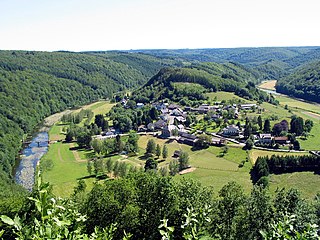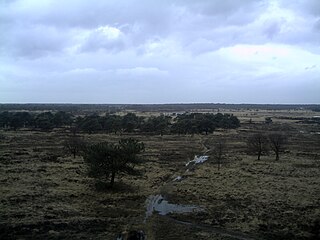 W
W't Asbroek is a nature domain and forest in the municipality of Schoten, Belgium, covering an area of 12 ha. The domain is owned by the municipality of Schoten and managed by nature conservation organisation Natuurpunt since 1998. It is officially recognised by the Flemish government as a nature reserve.
 W
WThe Ardennes, also known as the Ardennes Forest or Forest of Ardennes, is a region of extensive forests, rough terrain, rolling hills and ridges. Geologically, the range is a western extension of the Eifel, and both were raised during the Givetian age of the Devonian, as were several other named ranges of the same greater range.
 W
WThe Hallerbos is a forest in Belgium, covering an area of 552 ha. It is mostly situated in the municipality of Halle, in Flemish Brabant and has also a little part in Walloon Brabant.
 W
WMeerdaal, also known as Meerdaalwoud and Meerdaalbos, is a woodland lying east of Brussels and south of Leuven, on the loess plateau of Brabant in central Belgium. The bigger part of it has most likely been continuously forested since the Middle Ages, but the archaeological record and geomorphology give evidence of a profound human influence, probably including agriculture, during the Roman era and the Iron Age.
 W
WThe Peerdsbos is a forest and nature domain situated in the Belgian municipalities of Brasschaat and Schoten, to the north of the city of Antwerp. The domain largely consists of forests and directly borders the Vordenstein domain in Schoten to the south-east, and the Brasschaat municipal park to the northwest.
 W
WPloegsteert Wood was a sector of the Western Front in Flanders in World War I, part of the Ypres Salient. It is located around the village of Ploegsteert in the Walloon region of north-western Belgium.
 W
WPolygon Wood is a forest located between Ypres and Zonnebeke, West Flanders, Belgium. It was the scene for several battles during the First World War and there are at least two cemeteries of the Commonwealth War Graves Commission in the immediate vicinity of the wood.
 W
WSilva Carbonaria, the "charcoal forest", was the dense old-growth forest of beech and oak that formed a natural boundary during the Late Iron Age through Roman times into the Early Middle Ages across what is now western Wallonia. The Silva Carbonaria was a vast forest that stretched from the rivers Zenne and the Dijle in the north to the Sambre in the south. Its northern outliers reached the then marshy site of modern Brussels.
 W
WThe Sonian Forest or Sonian Wood is a 4,421-hectare (10,920-acre) forest at the southeast edge of Brussels, Belgium.
 W
WDe Zoom–Kalmthoutse Heide is a cross-border park on the Belgian–Dutch border. It is a merger of two former parks, the Kalmthoutse Heide in Belgium and De Zoom in the Netherlands, together extending over 37.50 square kilometres (14.48 sq mi). A very large part of the park is covered with heath.